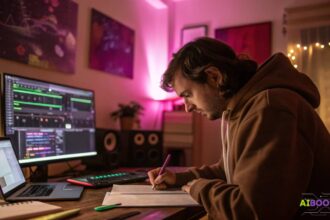They post daily yet progress little, mistaking movement for momentum.
The truth? You don’t need to create more — you need a system that creates for you.
AI allows you to publish daily without producing daily, shifting your focus from quantity to quality, from anxiety to architecture.
“Never mistake motion for action.” — Ernest Hemingway
This article reveals why the “daily creation” philosophy fails in the modern content economy — and how smart solopreneurs use automation, batching, and AI workflows to build a Content Operating System that runs while they rest.
Because in the age of intelligent publishing, creativity isn’t about how often you show up — it’s about how intentionally you build.
Publishing every day sounds heroic. It feels like discipline, momentum, hustle — everything we’re told success requires.
But in practice, “daily creation” often burns more energy than it builds. Most solopreneurs spend hours producing posts that disappear within hours. The result is a treadmill of effort without direction.
The truth is: consistency matters, but output frequency doesn’t. The smartest creators don’t post daily — they systemize daily visibility. And with AI, that shift from effort to efficiency has never been easier.
Why the “create every day” advice is broken
The internet rewards visibility, so naturally we think: more posts = more growth.
But if volume were the secret, the loudest would always win — and they don’t.
The burnout loop: effort without compounding results
Daily posting creates a false sense of progress.
You feel productive because you’re busy, but your ideas rarely mature. Each new piece resets the algorithm instead of compounding the previous one.
It’s like planting new seeds every morning and never watering yesterday’s.
True growth happens when content compounds — when one idea leads to the next, forming a recognizable voice.
Most solopreneurs quit not because they lack creativity, but because they confuse activity with architecture.
AI helps reverse that cycle. By analyzing your past posts, it can show which topics generate trust or conversions, so you can repurpose the best ones instead of starting from zero every day.
“It is not enough to be busy; so are the ants. The question is: what are we busy about?” — Henry David Thoreau
Consistency ≠ frequency
Posting daily doesn’t equal being consistent.
Consistency is about staying on message, not staying online.
Some creators publish twice a week but sound unmistakably aligned; others flood the feed and vanish from memory.
Think of frequency as noise and consistency as signal.
The signal compounds — the noise fades.
Use AI scheduling tools like Buffer AI or Metricool Smart Planner to map your publishing rhythm around focus, not fatigue.
You can maintain a daily presence through automation while creating only a few times per week.
“Without continual growth and progress, such words as improvement, achievement, and success have no meaning.” — Benjamin Franklin
What “daily presence” really means in the age of AI
Your audience doesn’t need you typing every day. They need you showing up every day — through content that feels fresh, relevant, and connected.
AI can make this happen effortlessly:
- Repurpose past posts with new hooks.
- Auto-generate short summaries for different platforms.
- Refresh old insights with current examples.
Presence is perception.
And perception can be automated — authenticity cannot.
When you understand this, “creating daily” stops being a grind and becomes a design.
“Simplicity is the ultimate sophistication.” — Leonardo da Vinci
From output to system: how publishing actually scales
The biggest shift for solopreneurs is moving from creator mode to system designer mode.
If your workflow depends on motivation, you’ll burn out. Systems don’t get tired.
Thinking like an engineer, not an artist
Artists chase inspiration; engineers build repeatable outcomes.
A content system is an engine that turns ideas into assets — automatically, a principle echoed by this Harvard analysis on responsible AI systems.
Start by documenting your process:
- How do ideas come to you?
- Where do you capture them?
- How do they become posts, emails, or videos?
Then ask AI to map and optimize it.
Example prompt:
“Analyze my content workflow and identify 3 steps that could be automated with AI tools (capture, editing, publishing).”
AI becomes your operations assistant. It finds friction and suggests automation.— a principle deeply explored in this guide.
That’s how you scale output without scaling exhaustion.
“Automation applied to an efficient operation will magnify the efficiency. Automation applied to an inefficient operation will magnify the inefficiency.” — Bill Gates
The leverage of pre-planned ideas
Daily creation drains creativity because every day starts blank.
Systemized creators think in batches. They capture ideas all week, refine them once, and schedule them strategically.
AI can categorize your ideas into clusters — productivity, branding, storytelling — and automatically suggest posting sequences.
By front-loading thinking, you multiply impact.
A single ideation session can fuel weeks of content.
| Step | Human Input | AI Contribution |
|---|---|---|
| Capture ideas | Voice notes, tweets | Transcribe & categorize |
| Refine concepts | Choose 3 main topics | Suggest angles & hooks |
| Publish & recycle | Approve & schedule | Format for each platform |
That’s not laziness — that’s leverage.
“Give me six hours to chop down a tree and I will spend the first four sharpening the axe.” — Abraham Lincoln
Replacing motivation with mechanisms
Most creators rely on “feeling inspired.” Systems rely on triggers.
When idea capture and scheduling are automated, your creativity becomes optional — not obligatory.
That freedom unlocks quality.
Instead of chasing the next post, you can improve the entire pipeline.
AI can remind you when a topic underperformed and needs reframing, or when an old article should be resurfaced with a new intro.
This turns creativity into a compounding asset, not a daily chore.
As shown later in The Content OS Framework, your goal isn’t to create content faster — it’s to create a system that never stops working for you.
The role of AI in freeing your creative bandwidth
The most productive creators don’t create more — they remove what blocks them from creating at all.
AI isn’t here to replace your spark. It’s here to clear the cognitive clutter that keeps you from using it, a balance also explored in this Oxford research.
Turning ideation into automation
Idea capture is where most solopreneurs waste the most energy.
They rely on inspiration instead of building a capture habit.
AI can automate this step beautifully: transcribe voice notes, extract hooks from long texts, and even tag themes automatically.
Use Notion AI or Mem X to build what author Tiago Forte calls a “second brain” — a system that remembers what your mind shouldn’t have to.
Once ideas are stored, you can connect them later instead of constantly starting from zero.
“Your mind is for having ideas, not holding them.” — David Allen
By delegating memory to machines, you free your focus for creation, not collection.
How AI acts as a “creative buffer”
Between the spark of an idea and the published post lies friction — editing, formatting, rewriting.
AI absorbs that friction. It handles structure so you can stay in flow longer.
Imagine dictating thoughts into an AI tool that turns them into outlines, ready for refinement.
This doesn’t reduce authenticity; it preserves momentum.
As psychologist Mihaly Csikszentmihalyi showed in his research on flow, creativity thrives when distractions disappear.
AI removes the micro-decisions that pull you out of that state, reinforcing the foundation of this system.
“The best moments in our lives are not passive, receptive, relaxing times… but when we are fully engaged in a meaningful challenge.” — Mihaly Csikszentmihalyi
Framework: The 3-Tier Creation Cycle (Capture → Cluster → Convert)
| Tier | Purpose | Example Tools |
|---|---|---|
| Capture | Store raw ideas automatically | Mem X, Notion AI, Obsidian + Whisper |
| Cluster | Group by topic or emotion | ChatGPT topic clustering, Airtable |
| Convert | Turn into publishable pieces | Jasper AI, Copy AI, Descript |
This cycle turns chaotic creativity into a calm, repeating process.
The more you refine the pipeline, the less energy you waste thinking how to create — you just do it.
“In preparing for battle I have always found that plans are useless, but planning is indispensable.” — Dwight D. Eisenhower
AI gives you the plan; you provide the purpose.
Real-world examples of creators who publish smarter, not harder
Learning systems is one thing. Seeing them in action is another.
Let’s look at how real solopreneurs use AI to replace stress with structure.
The solopreneur who built a one-hour content routine
Lina, a freelance brand designer, used to spend five hours writing LinkedIn posts weekly.
After building a Notion + ChatGPT workflow, she now spends one hour outlining, editing, and scheduling.
Her engagement didn’t just stay stable — it grew, because she finally had bandwidth to comment, connect, and think.
The newsletter creator who uses AI drafts to save time
Jonas, who writes a weekly productivity newsletter, feeds his archive into ChatGPT.
The tool analyzes tone and re-summarizes older essays into short “daily” tips.
He doesn’t “create daily” — his past work does.
“Do not confuse motion and progress. A rocking horse keeps moving but does not make any progress.” — Alfred A. Montapert
The podcaster who multiplies content with transcript repurposing
Podcaster Amina uploads each episode transcript to Claude AI.
It extracts quotes, builds tweet threads, and drafts show notes.
Within an hour, one recording becomes 10 pieces of content — each consistent in voice and message.
Her visibility compounds without extra effort.
These aren’t outliers. They’re examples of what happens when creativity meets structure.
The modern solopreneur doesn’t work harder — they design smarter.
“Productivity is being able to do things that you were never able to do before.” — Franz Kafka
The myth of daily creation keeps creators trapped in survival mode.
What looks like discipline is often disguised inefficiency.
The real power lies in building a content system that works even when you don’t.
AI transforms discipline into design — a framework that protects your energy and multiplies your ideas.
Once the process runs, your creativity becomes strategic, not sporadic.
“Don’t work for recognition, but do work worthy of recognition.” — H. Jackson Brown Jr.
The future of creation isn’t about typing faster.
It’s about thinking clearer, planning smarter, and letting machines handle the repetition.
Because the goal isn’t to create every day — it’s to stay visible every day, with less effort and more intent.
When your system works, your creativity finally breathes.
And that’s when the magic — and the growth — begins.
The creators who win aren’t the ones posting the most — they’re the ones thinking in systems.
Every new algorithm, every AI tool, rewards structure over struggle.
The shift is no longer from inspired to disciplined — it’s from manual to designed.
“It is not the strongest of the species that survive, nor the most intelligent, but the one most responsive to change.” — Charles Darwin
Let AI handle the repetition so you can focus on resonance.
Build habits that make creativity inevitable instead of exhausting.
Your role isn’t to keep producing noise — it’s to refine your signal until it becomes unmistakably yours.
To scale your presence without burning out, continue with:
- The Content OS Framework — learn how to structure your entire publishing system.
- 7-Day AI Content Calendar That Runs Itself — see how to automate rhythm and consistency.
- Content Machines: Build a Daily Publishing Engine with AI — the full blueprint that ties everything together.
Because you don’t need to post harder — you need to post smarter.
And the moment you replace hustle with design, your content stops chasing attention and starts earning authority.






